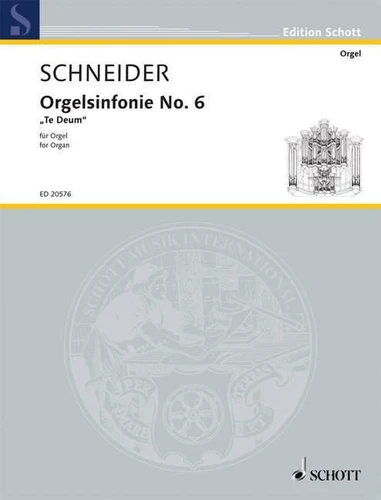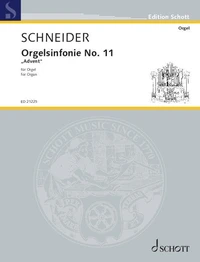Edition Schott
Orgelsinfonie No. 6. "Te Deum". organ.
Par : Formats :
- Paiement en ligne :
- Livraison à domicile ou en point Mondial Relay indisponible
- Retrait Click and Collect en magasin gratuit
- Réservation en ligne avec paiement en magasin :
- Indisponible pour réserver et payer en magasin
- Nombre de pages60
- Poids0.241 kg
- Dimensions23,1 cm × 30,3 cm × 0,0 cm
- ISBN979-0-001-15793-3
- EAN9790001157933
- Date de parution01/01/2009
- CollectionORGUE
- ÉditeurSchott
Résumé
With his organ symphonies, the composer Enjott Schneider (born 1950) from Munich has been a profound sensation in recent years and seen world premieres at major European organ events. The Organ Symphony No. 6 'Te Deum' (premiered at Bruckner's St. Florian above Bruckner's tomb in 2008 and recorded there on CD) adopts the five-part structure and several motifs from Bruckner's 'Te Deum', thus becoming a forceful compact work pervaded by the Gotteslob.
1 : 'Te Deum' is based on Bruckner's original figuration of fifths and eighths which is connected with the Latin Te Deum ; 2 : 'Te Ergo' is a 'preghiera' with pleading and praying gestures ; 3 : 'Aeterna fac' is an extremely virtuoso perpetuum mobile ; 4 : 'Salvum Fac' a basso ostinato and finally 5 : 'In te, Domine speravi' a toccata which, after taking many detours, inevitably leads to the C major.
Instrumentation : organ
1 : 'Te Deum' is based on Bruckner's original figuration of fifths and eighths which is connected with the Latin Te Deum ; 2 : 'Te Ergo' is a 'preghiera' with pleading and praying gestures ; 3 : 'Aeterna fac' is an extremely virtuoso perpetuum mobile ; 4 : 'Salvum Fac' a basso ostinato and finally 5 : 'In te, Domine speravi' a toccata which, after taking many detours, inevitably leads to the C major.
Instrumentation : organ
With his organ symphonies, the composer Enjott Schneider (born 1950) from Munich has been a profound sensation in recent years and seen world premieres at major European organ events. The Organ Symphony No. 6 'Te Deum' (premiered at Bruckner's St. Florian above Bruckner's tomb in 2008 and recorded there on CD) adopts the five-part structure and several motifs from Bruckner's 'Te Deum', thus becoming a forceful compact work pervaded by the Gotteslob.
1 : 'Te Deum' is based on Bruckner's original figuration of fifths and eighths which is connected with the Latin Te Deum ; 2 : 'Te Ergo' is a 'preghiera' with pleading and praying gestures ; 3 : 'Aeterna fac' is an extremely virtuoso perpetuum mobile ; 4 : 'Salvum Fac' a basso ostinato and finally 5 : 'In te, Domine speravi' a toccata which, after taking many detours, inevitably leads to the C major.
Instrumentation : organ
1 : 'Te Deum' is based on Bruckner's original figuration of fifths and eighths which is connected with the Latin Te Deum ; 2 : 'Te Ergo' is a 'preghiera' with pleading and praying gestures ; 3 : 'Aeterna fac' is an extremely virtuoso perpetuum mobile ; 4 : 'Salvum Fac' a basso ostinato and finally 5 : 'In te, Domine speravi' a toccata which, after taking many detours, inevitably leads to the C major.
Instrumentation : organ





















